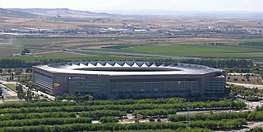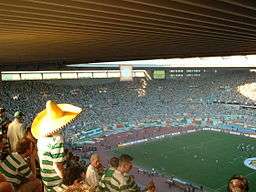Estadio de La Cartuja
Estadio La Cartuja, officially known as Estadio La Cartuja de Sevilla, is a multi-purpose stadium situated in the Isla de la Cartuja in Seville, Spain. It is used mostly for football and it is commonly referred to as simply 'la Cartuja'. It was completed in 1999 for the World Championships in Athletics. With a capacity of 60,000 seats, La Cartuja is the 6th-largest stadium in Spain and the 2nd-largest in Andalusia.[1] It was the venue for the 2003 UEFA Cup Final between Celtic and Porto, and will also be the venue for the upcoming 2020 Copa del Rey Final between Real Sociedad and Athletic Bilbao.
La Cartuja | |
 | |
| Location | Seville, Spain |
|---|---|
| Owner | Regional Government of Andalusia (40%) Spanish Government (25%) Seville City Council (19%) Seville Congress of Deputies (13%) Real Betis (1.5%) Sevilla FC (1.5%) |
| Operator | Sociedad Estadio Olímpico de Sevilla S.A. |
| Capacity | 60,000 |
| Field size | 105 x 68 m |
| Surface | Grass |
| Construction | |
| Broke ground | 1997 |
| Opened | 5 May 1999 |
| Construction cost | EUR120 million |
| Architect | Antonio Cruz Villalón Antonio Ortiz García |


History
The stadium was one of those included in the Seville bid for the 2004 and 2008 Summer Olympics. After the failure of the last bid, the stadium remained unused by either of Seville's major football teams as both Real Betis and Sevilla use their own stadia. However, both teams have expressed their intention to move temporarily while their respective home grounds are renovated.
The stadium is currently managed by the Sociedad Estadio Olímpico de Sevilla S.A., participated by the Regional Government of Andalusia (40% ownership), the Spanish Government (25%); Seville City Council (19%), Seville Congress of Deputies (13%) and the remaining 3% shared between Seville's two football clubs: Real Betis and Sevilla FC.
The Spanish national football team occasionally use the stadium for home games, last playing there in 2012. The stadium has previously hosted the final of the Copa del Rey. Real Betis's home game against Villarreal on 31 March 2007 also took place here following a temporary ban from the Manuel Ruiz de Lopera.
The Royal Spanish Tennis Federation has chosen it twice to host the Davis Cup final, in 2004 and 2011. On both occasions a temporary roof was installed on one side of the stadium, where the clay court was placed.[2]
On 5 February 2020, the stadium was chosen by the Royal Spanish Football Federation for hosting four Copa del Rey finals from 2020 to 2023.[3]
International matches
| Date | Competition | Spain vs. | Result |
|---|---|---|---|
| 5 May 1999 | Friendly (inauguration) | 3-1 | |
| 17 November 1999 | Friendly | 0-2 | |
| 15 November 2000 | Friendly | 1-2 | |
| 3 June 2012 | Friendly | 1-0 | |
Notable music events
On 9 October 1999, Mexican singer Luis Miguel performed a concert at the Stadium in front of 35,000 spectators during his Amarte Es Un Placer Tour.
On 16 September 2008, American entertainer Madonna played a concert in front of 47,712 spectators during her Sticky & Sweet Tour.
U2 performed at the stadium on September 30, 2010 during their U2 360° Tour, in front of a sold-out crowd of 76,159 people.
Depeche Mode were scheduled to perform at the stadium on July 12, 2009 as part of their Tour of the Universe, but the concert was cancelled due to singer Dave Gahan's leg injury.
Bruce Springsteen performed at the stadium on May 13, 2012 as part of his Wrecking Ball World Tour in front of 22,045 people.

AC/DC performed here on 10 May 2016 as part of their Rock or Bust World Tour in front of 60,000 people.
See also
References
- "The stadium". Archived from the original on 2018-08-19. Retrieved 2016-03-08.
- "La Federación elige a Sevilla para la final de la Davis" (in Spanish). El País.
- "El Estadio de La Cartuja acogerá la final de la Copa del Rey" (in Spanish). Royal Spanish Football Federation. 5 February 2020.
External links
- Official website
- Spanish football stadiums
- Photos of the Estadio Olimpico Football Temples of the World
- Estadios de Espana
| Preceded by Olympic Stadium Athens |
IAAF World Championships in Athletics Main venue 1999 |
Succeeded by Commonwealth Stadium Edmonton |
| Preceded by De Kuip Rotterdam |
UEFA Cup Final venue 2003 |
Succeeded by Ullevi Gothenburg |
| Preceded by Rod Laver Arena Melbourne |
Davis Cup Final venue 2004 |
Succeeded by Sibamac Arena Bratislava |
| Preceded by Belgrade Arena Belgrade |
Davis Cup Final venue 2011 |
Succeeded by O2 Arena Prague |